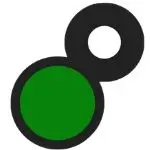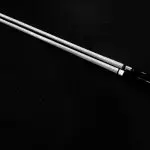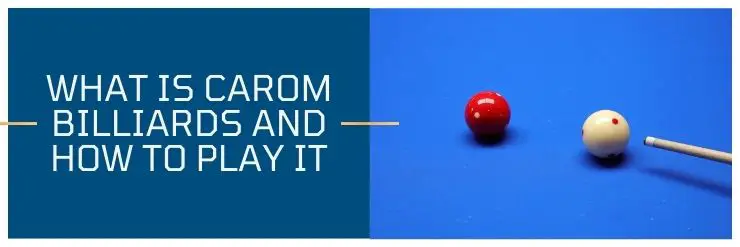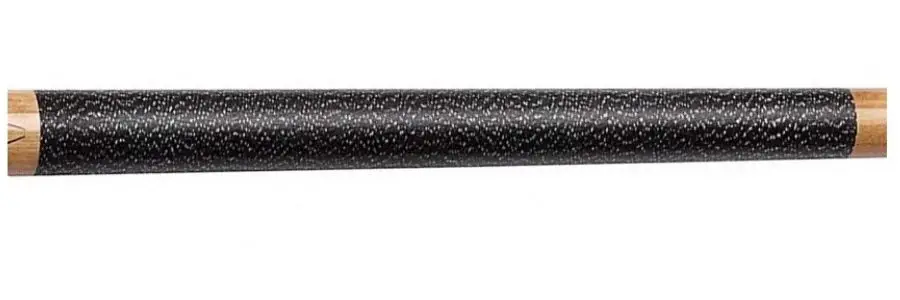If you want to play pool, snooker or billiards like a pro, then you need to ensure that your pool stick is in perfect shape. You want it perfectly straight so that you can see its tip when you aim.
You can always play with a cue that has minor deformities or warps unless the distortions are too close to the tip.
There are a lot of professionals who do. However, if you’re still low on the learning curve, then having a ramrod straight pool cue is indispensable. But how do you determine that your pool stick is as straight as an arrow without any deviations or irregularities?
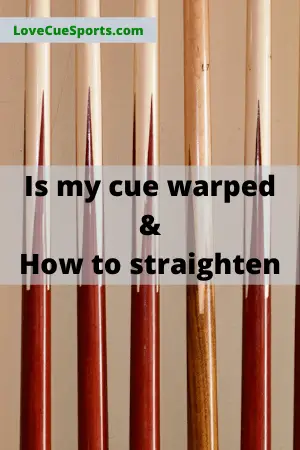
First, you’ll need to determine if your pool cue is in fact warped, you can do this by sighting the cue. If your billiard stick is bent then there are a couple of things you can do to rectify this. The easiest way is to hang your cue up and allow the wood to straighten on its own.
This article will run through everything you need to know, from determining if your cue is in fact bent and ways you can straighten your cue.
We will also give some bonus tips on how to speed up the straightening process of your cue, so keep reading to learn everything you need to know on how to straighten a pool cue back to perfect playing condition.
- How to check if a pool cue is straight
- Why rolling your cue on the table isn’t a good indicator of straightness
- How to straighten a cue
- The dos and don’ts of keeping the cue perfectly straight
- What causes a pool cue to warp
- How do I keep my pool cue from warping
- What other things should be considered when checking which cue to use
- Conclusion
How to check if a pool cue is straight
 Though there are many ways of checking the straightness of a pool cue, ‘sighting the cue’ continues to be the most effective technique and hence extremely popular. To ‘sight a shaft,’ you’ll have to raise it and keep it steady at your eye level. Continue to hold the butt end of the cue steadily and firmly, and gaze down towards the shaft’s tip.
Though there are many ways of checking the straightness of a pool cue, ‘sighting the cue’ continues to be the most effective technique and hence extremely popular. To ‘sight a shaft,’ you’ll have to raise it and keep it steady at your eye level. Continue to hold the butt end of the cue steadily and firmly, and gaze down towards the shaft’s tip.
Trying to look down from the pool stick’s butt end towards the tip is akin to aiming with a rifle. Now, lower the cue a bit, and rotate it in a 360˚ angle very slowly, and continue looking down from the butt end. If the tip end is fully visible throughout and you don’t spot any twisting or warping, you can safely conclude that the cue is seamlessly straight.
Another efficient way of making sure that the pool cue is straight throughout is to hold its butt and position its tip on the floor. After that, incline the shaft at a 60˚ vis-à-vis the floor. Now, turn the stick on its pointed end bit by bit and look down at the tip from the butt end.
Check out for any deformity or distortion while you see down; if you spot any warping on a section, you can infer that you’re staring at a bent cue. Make sure the room where you’re conducting the test is fully illuminated, or else you may not be able to pick out any abnormality.
Why rolling your cue on the table isn’t a good indicator of straightness
Many individuals, (and that includes seasoned players as well) that you can establish the cue’s straightness by rolling it on the table’s playfield. However, rolling the pool stick on the table is not an effective way of ensuring its straightness for some obvious reasons. For a start, the pool table’s play area surface on which you roll the cue may not be perfectly flat.
Then again, the stick could quiver or shake a bit if there is a minuscule imperfection in the table felt or cloth, thereby negating the rolling test. Bear in mind that your pool cue could wobble (even if the pool cue is straight) even with the slightest of variations in the felt. Remember that pool cues are not thoroughly conical but have a slight degree of tapering.
The tapering profile implies that the shaft’s diameter is not the same throughout but rather decreases gradually towards the tip. It is the narrowing of the stick that makes the shaft wobble or shake when you roll it on the pool table. Weight and price labels also have an impact on the cue’s rolling consistency.
More often than not, the inconsistencies or imperfections of the slate and the debris or dust on the table could interfere with the cue’s rolling. If you wish to take optimum advantage of the rolling technique, you’ll have to constantly keep your eye out for the cue tip’s motion. Nevertheless, sighting the cue is the best way of establishing whether the stick has any abnormality or defect.
It does not need to be emphasized that you should doubly ensure the pool stick is not bent or twisted before buying it.
How to straighten a cue
Pool players have traditionally used wooden pool sticks for the simple reason that cues made from wood perform better than fiberglass shafts. The only downside of using a pool cue made of wood is that it tends to warp with time. However, you’d be delighted to know that you can always straighten a cue if it warps or bends.
Luckily for you, you don’t need some pool cue straightening tool! Although it sounds somewhat eccentric;
you can restore the shaft’s straightness by suspending it upright from the ceiling with the help of a string. Just leave the stick hanging from the ceiling for a couple of weeks as the force of gravity will bring it back to shape.
The shaft’s weight should suffice for straightening minor warps or deformities in 3-4 weeks.
Once you have taken these steps to straighten your cue, I highly recommend getting a protective cue case. It will help against future warping and damage to your cue.
If you are looking for a faster fix to your warped cue, another tried-and-tested way of fixing negligible bends or curves is to use the power and heft of your arms. Position the cue on the floor at an angle of 60˚ to the surface, and place the palm of your left or right hand exactly on the warping. Now apply pressure on the bend with your palm all the time, keeping the shaft stable.
Keep putting pressure until the bend evens out. However, be careful enough not to press too hard or you might end up cracking or breaking it. Once you’ve straightened the bend, turn the shift slowly, and repeat the procedure till you feel that the stick’s straightness has been restored.
The dos and don’ts of keeping the cue perfectly straight
Following are some tips that will enable you to keep your shaft as ramrod as an arrow:-
THE DO’s
- Store your pool stick in a hard polyform cue case or cushioned case when you’re done with playing. Storing the shaft in a padded case secures it and protects it from damage.
- Store the cue case in a cool and dry place or better still if you keep the case in a temperature-controlled room. .
- Treat with respect and care -cues are expensive, especially intermediate and higher-level pool cues, so make sure you look after them!
THE DONT’s
- Never use steel wool for cleaning the cue, and also avoid sanding. Using steel wool exposes the pores in the wood to dirt and humidity, thereby affecting its durability. Clean your cue with a clean, dry piece of cloth or rag. Once you’re done with cleaning the stick, reseal the cue with a wax or sealant..
- Never rest the cue against the wall or place it close to a source of heat such as a fireplace or radiator. The heat could lead to warping of the cue..
- Do not leave the cue behind in your vehicle trunk or in any place that is cold and dank or hot and humid. .
- Do not lean or press down on the cue with your hands in between your shots. The pressure you exert on the shaft by leaning on it could change its shape.
What causes a pool cue to warp
There are a few things that can cause a pool cue to warp, but the most common reason is simply due to changes in temperature or humidity. If your cue is stored in a place where there are drastic changes in either of these conditions, it’s more likely to warp over time.
Other possible causes of warping include incorrect cleaning or maintenance or using the cue for activities that it’s not designed for (such as striking a hard surface).
If you’re concerned that your cue may be warped, there are a few ways to check. One way is to hold the cue up to the light and look down the shaft – if you can see light shining through, then the cue is likely warped.
Can you straighten a pool cue, is the question been asked in this post, and by following the step-by-step instructions above you have a good chance at fixing any warped cue.
How do I keep my pool cue from warping
There are a few things you can do to prevent your pool cue from warping.
Avoid leaving your cue in direct sunlight or in a hot car for extended periods of time.
Use a cue rack or cue case to store your cue when not in use and avoid leaning it against walls or other hard surfaces.
Clean your pool cue regularly with a soft cloth and pool cue cleaner to remove dirt, grime, and chalk build-up.
Never store your cue in a humid environment or near a heat source.
If you take proper care of your pool cue, it should last for many years without warping
What other things should be considered when checking which cue to use
So your at a bar or pool hall and you want to choose the best possible cue to play with. You now know how to determine if the cue is straight or not, so what else do you need to consider?

Better players are aware of what they need to consider before choosing a pool cue. But if you’re someone who is still learning the ropes, you can make the most of these tips for choosing a pool cue to play with:-
The shaft’s weight
Pool shafts’ weight varies from 17oz (ounce) to 21oz (ounce). Now, the weight that you will be comfortable with is a matter of individual choice. Anyway, the majority of players either go-between 19-ounce to 21ounce cue.
I would pick it up at the butt of the cue, and feel how heavy it is, you don’t want it to be too light because the extra weight helps, that being said, you don’t want one that is too light.
Length of the cue
Choosing a thoroughly straight shaft with a length that you’d be perfectly comfortable with should be your primary consideration. A good rule of thumb is to choose a cue whose length is the same as your arm. Opting for a shaft that perfectly aligns with your arm offers you full leeway over the game.
That said, a typical two-piece shaft measuring 58 inches can be used conveniently by anybody whose height ranges between 5’8” and 6’5”. In case your height is below or above this range, then you’ll need to go for a cue with a length of 48/52 inches and 61 inches, respectively.
Cue Wrap type
You can get a shaft wrapped in linen, rubber, or leather. Leather or linen wraps suit those who tend to perspire heavily. Rubber wraps offer you a good grip but they eventually become slippery and wear out quickly. No matter whatever drape type you choose, stay away from cues that come without any wraps as you won’t be able to grip these sticks firmly.
The tip of the cue
Cues come with hard, soft or medium tips. generally speaking, sort tips help apply more english while hard tips help with more power. If you’re starting, go for a cue with a medium tip.
You want to visually inspect the tip, and ensure it has a dome shape without any mushrooms or splits. The tip shouldn’t be too tightly compacted as this will hinder its ability to hold chalk and cause more miscues.
Conclusion
So, there you are; we have listed all the effective techniques you can use for checking out if your pool cue is straight or not. Always ensure that your shaft is without any warps or bends before you go on to play pool snooker or billiards.
Rob is an avid player and fan of all cue sports, particularly 8-ball, and snooker. He has competed in a few local 8-ball tournaments and although he is not a professional, he can compete with the best of them.
